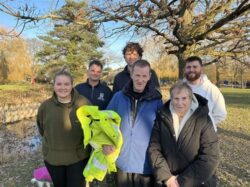The group of baffled fishermen and women say there was no warning or reason given for the closure (Picture: SWNS)
Furious anglers in a medieval market town are fighting their local council’s decision to ban fishing in a popular and historic moat.
They say they were given no reason for the impending closure which will end their pastime.
Baffled fishermen and women say their local council suddenly ordered them to stop fishing in the ‘beautiful’ moat – which once surrounded a manor house – without fully explaining why.
The popular fishing spot at Park Farm in Ashford, Kent, has served as a place of quiet refuge for generations of anglers for more than 26 years.
Ashford Borough Council (ABC) suddenly announced that fishing at the moat would cease next month, without offering a suitable explanation to those who have spent countless happy days there.
Angry anglers who frequent the spot are now demanding answers as to why they must leave their favourite fishing spot behind.
Along with Kingsnorth Parish Council (KPC), the local fishing community is now banding together to fight the ban by launching a petition to save the moat, which has been fished in since 1996.
Robert Heath, a decade-long member of Stanhope Angling Club, spends a large amount of his time fishing the moat and explained that the ban would be incredibly sad for the local community.
To view this video please enable JavaScript, and consider upgrading to a web
browser that
supports HTML5
video
The idyllic spot has attracted anglers for more than 26 years (Picture: SWNS)
He said: ‘I usually come here about five times a week.
‘I think the communication aspect of the decision is more upsetting.
‘They have said ‘no fishing’, but we have been asking the question, ‘why?’.
‘After 24 years of being someone’s tenant, you would have thought out of respect that you deserve more than that.
‘We have been led to believe it is a financial issue and we do know how much it is going to cost to de-silt this moat.
Robert Heath, a proud member of the Stanhope Angling Club (Picture: SWNS)
‘What will happen to the moat is a bigger issue… It will go to rack and ruin.
‘I want someone to tell me where else kids can go for a day out at just £5 – because there are not many places.
‘But come the end of March, they’re mad if they think people won’t come fishing here anymore.
‘There will be more people fishing here than we have in our club.’
Jemma Coales said fishing at the lovely site has helped her out of a ‘deep dark spot’ (Credits: KMG / SWNS.COM)
Jemma Coales, who has been fishing in the moat for around 18 years, most of her life, says the activity has helped her cope with her mental health struggles.
The 23-year-old said: ‘It’s a really great nature spot and a beautiful nature spot.
‘We’ve built a nice close-knit community around here where we all speak to each other.
‘It has got me out of a deep dark spot and it is a good distraction and a good coping mechanism that I use and I would hate to see it go.’
Jemma has been angling at the moat since she was around five years old (Picture: SWNS)
Another fisherwoman, Sandra Clarke, says multiple generations of her family have learned to fish at the moat.
The 75-year-old said: ‘I have been in Ashford for 50 odd years and 22 years in Park Farm.
‘I have always been a fisherwoman from a very young age – I taught my boys to fish and they have now taught their children to fish.
In a bid to save the beloved site, KPC has launched an online petition to preserve the moat, which once surrounded a medieval manor house.
The moat once surrounded a manor house (Picture: SWNS)
It is hoped the petition will reach 1,500 signatures, which would ensure it was discussed in council chambers.
A spokesman for ABC added: ‘Following our discussions in 2022 with the angling club, parish council and ward members an agreement has been reached to cease fishing at the moat site situated in Park Farm from the end of March 2023.
‘The moat is not a public fishery, and to fish there you need to be part of the angling club.
‘We will continue to maintain the site as a public open space and for the wider biodiversity opportunities that the moat provides.’





